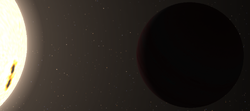WASP-4
 Artistic rendering of WASP-4 b | |
| Observation data Epoch J2000.0 Equinox J2000.0 | |
|---|---|
| Constellation | Phoenix[1] |
| Right ascension | 23h 34m 15.0857s[2] |
| Declination | −42° 03′ 41.048″[2] |
| Apparent magnitude (V) | 12.468±0.025[3] |
| Characteristics | |
| Spectral type | G7V[4] |
| Apparent magnitude (V) | 12.468±0.025[3] |
| Apparent magnitude (B) | 13.216±0.020[3] |
| Variable type | Planetary transit variable[4] |
| Astrometry | |
| Proper motion (μ) | RA: 9.950(12)[2] mas/yr Dec.: −87.620(10)[2] mas/yr |
| Parallax (π) | 3.6623 ± 0.0147[2] mas |
| Distance | 891 ± 4 ly (273 ± 1 pc) |
| Details[5][6] | |
| Mass | 0.89±0.01 M☉ |
| Radius | 0.915+0.03 −0.043[7] R☉ |
| Surface gravity (log g) | 4.484+0.037 −0.047[7] cgs |
| Temperature | 5436±34 K |
| Metallicity [Fe/H] | 0.019±0.04 dex |
| Rotation | 22.20±3.30 d |
| Age | 6.27±2.34 Gyr |
| Other designations | |
| Database references | |
| SIMBAD | data |
WASP-4 is a G-type main sequence star approximately 891 light-years away in the constellation of Phoenix.[4][1][2] Despite its advanced age, the star is rotating rapidly, being spun up by the tides raised by a giant planet on close orbit.[6]
Planetary system[]
In 2007 the extrasolar planet WASP-4b was discovered orbiting this star. With an orbital period of just 1.3 days it is classified as a hot Jupiter.[4] The planetary orbit is subject to rapid decay, with decay timescale of 15.77±1.57 million years. Another superjovian planet in the system is suspected.[9]
| Companion (in order from star) |
Mass | Semimajor axis (AU) |
Orbital period (days) |
Eccentricity | Inclination | Radius |
|---|---|---|---|---|---|---|
| b | 1.216±0.013 MJ | 0.0228±0.00013 | 1.338231587±0.000000022[9] | 0 (assumed) | 87.63+0.32 −0.28° |
1.33±0.16 RJ |
See also[]
- SuperWASP
- List of extrasolar planets
References[]
- ^ a b Roman, Nancy G. (1987). "Identification of a Constellation From a Position". Publications of the Astronomical Society of the Pacific. 99 (617): 695–699. Bibcode:1987PASP...99..695R. doi:10.1086/132034. Vizier query form
- ^ a b c d e f Brown, A. G. A.; et al. (Gaia collaboration) (2021). "Gaia Early Data Release 3: Summary of the contents and survey properties". Astronomy & Astrophysics. 649: A1. arXiv:2012.01533. Bibcode:2021A&A...649A...1G. doi:10.1051/0004-6361/202039657. S2CID 227254300. Gaia EDR3 record for this source at VizieR.
- ^ a b c Henden, A. A.; et al. (2016). "VizieR Online Data Catalog: AAVSO Photometric All Sky Survey (APASS) DR9 (Henden+, 2016)". VizieR On-line Data Catalog: II/336. Originally Published in: 2015AAS...22533616H. 2336. Bibcode:2016yCat.2336....0H. Vizier catalog entry
- ^ a b c d Wilson, D. M.; et al. (2008). "WASP-4b: A 12th Magnitude Transiting Hot Jupiter in the Southern Hemisphere". The Astrophysical Journal Letters. 675 (2): L113–L116. arXiv:0801.1509. Bibcode:2008ApJ...675L.113W. doi:10.1086/586735. S2CID 10823235.
- ^ a b Petrucci, R.; et al. (2013). "No Transit Timing Variations in Wasp-4". The Astrophysical Journal Letters. 779 (2). L23. arXiv:1311.2048. Bibcode:2013ApJ...779L..23P. doi:10.1088/2041-8205/779/2/L23. S2CID 118376692.
- ^ a b Maxted, P. F. L.; Serenelli, A. M.; Southworth, J. (2015), "A comparison of gyrochronological and isochronal age estimates for transiting exoplanet host stars", Astronomy & Astrophysics, 577: A90, arXiv:1503.09111, Bibcode:2015A&A...577A..90M, doi:10.1051/0004-6361/201525774, S2CID 53324330
- ^ a b c Dragomir, Diana; Kane, Stephen R.; Pilyavsky, Genady; Mahadevan, Suvrath; Ciardi, David R.; Zachary Gazak, J.; Gelino, Dawn M.; Payne, Alan; Rabus, Markus; Ramirez, Solange V.; von Braun, Kaspar; Wright, Jason T.; Wyatt, Pamela (2011). "Terms Photometry of Known Transiting Exoplanets". The Astronomical Journal. 142 (4): 115. arXiv:1108.2308. Bibcode:2011AJ....142..115D. doi:10.1088/0004-6256/142/4/115. S2CID 118606598.
- ^ "WASP-4". SIMBAD. Centre de données astronomiques de Strasbourg. Retrieved 2018-09-22.
- ^ a b Characterizing the WASP-4 system with TESS and radial velocity data: Constraints on the cause of the hot Jupiter’s changing orbit and evidence of an outer planet, 2021, arXiv:2112.09621
- ^ Huitson, C. M.; et al. (2017). "Gemini/GMOS Transmission Spectral Survey: Complete Optical Transmission Spectrum of the Hot Jupiter WASP-4b". The Astronomical Journal. 154 (3). 95. arXiv:1707.06575. Bibcode:2017AJ....154...95H. doi:10.3847/1538-3881/aa7f72. S2CID 119415111.
External links[]
- "SuperWASP Homepage". Archived from the original on 2002-12-08. Retrieved 2008-07-02.
- "UK planet hunters announce three new finds" (PDF). 2007-10-30. Archived from the original (PDF) on 2008-05-16. Retrieved 2008-07-02.
Coordinates: ![]() 23h 34m 15.06s, −42° 03′ 41.1″
23h 34m 15.06s, −42° 03′ 41.1″
Categories:
- Phoenix (constellation)
- G-type main-sequence stars
- Planetary systems with one confirmed planet
- Planetary transit variables
- Wide Angle Search for Planets
- 2MASS objects
- Variable star stubs